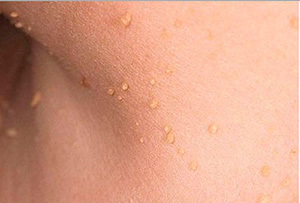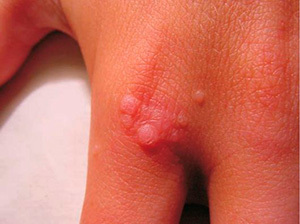
Papillomas or warts are the most common disease. The presence of growths on the skin is noted in 80% of the population. This defect is caused by the human papilloma virus (HPV). Neoplasms can occur anywhere on the body: neck, arms, face, external genitals, as well as internal internal organs. However, these neoplasms, which are not dangerous at first glance, can turn into malignant formations and cause melanoma - skin cancer.
Papillomas consist of the superficial skin epithelium (warts) and the mucous membrane of the internal organs (condylomas). They can be of various shapes, round or club-shaped, mostly rise above the skin and have a typical color. Each wart has the same type of structure: a base consisting of connective tissue (collagen and elastin in a composition of loose fibrous tissue, giving the stroma skeleton flexibility) and capillaries located in the center of the wart.
Why do small papillomas appear on the body?
The only cause of any growth in the body is HPV damage due to a weakened immune system. There are about 120 known types of viruses. Infection most often occurs after a delayed inflammatory process. The viral activity of HPV depends on the immune state and the individual response of the human body.
Small damage to skin areas, various micro traumas, violation of the epidermal barrier, allowing the virus to penetrate into the upper layers of the skin. This virus does not travel through the bloodstream, but is found directly in the dermis. Therefore, the incubation period is not less than 3 months and not more than 5 months. It progresses with hidden symptoms. There will be visible clinical changes after only 5 months. The double DNA helix, which is part of this, allows the disease to recur even after an immune response or clinical treatment, as a single DNA is retained in the cells of the epidermis.
There are four main causes of virus infection:
- Contact and household reason - physical contact (handshaking) with the carrier of this virus, as well as the use of items of personal hygiene of the patient.
- Suppressed effect of the general and local immune system due to the current inflammatory process or constant stress.
- Mother to child (anogenital warts). It is transmitted at birth and has a high risk of progression and has a wide range of distribution.
- Sexual contact with a patient with HPV in 50% of cases.

Infection through contact with households ranks first in terms of the number of cases. Hands are the most exposed and unprotected part of the body. For this reason, small papillomas are often seen on the hands.
Papillomas are classified according to various morphological classifications.
There are small and large papillomas according to the size.
Warts look like this:
- Ordinary- localized in the free arch of the upper extremities: the palmar surface of the hand, phalanges of the fingers, elbow, back of the hand. They are global.
- Simple- found all over the body, mostly on the neck and arms. They look like a gray bubble rising above the skin.
- Pointed- look like a cockerel. They are small and white in appearance, club-shaped.
- Seborrheic keratosesare age-related warts. Keratinous, non-pathogenic due to a different origin.
- Thornsare the toughest and toughest. Usually large and high above the skin.
By location: plantar (hands and feet), flat (papillomas on the body), ordinary (hands), butcher's warts (on the plantar surface of the foot).
Etiology of warts: congenital and acquired.
Often, patients may have small papillomas. And it is this species that can form groups.
What is the danger of small papillomas
The danger of small papillomas is that they are hardly visible on the body and can appear unexpectedly. This increases the risk of contracting HPV.

If you have small warts after skin contact, be sure to see a dermatologist. A highly specialized doctor will be able to distinguish the type of papilloma and its duration of existence, which will be the basis for prescribing treatment.
Do not tear it off, try to get rid of small papillomas on your own and even with the help of folk methods. You may be doing yourself a disservice! Since benign neoplasms pose a risk of degeneration to oncology, the resulting growths should be removed at the clinic.
Some types of human papillomavirus are highly oncogenous. And they can trigger not only skin cancer (melanoma), but also cervical cancer (in women) and anal ring (in men), the formation of polyps of internal organs.
Papillomas on the body are found in areas of increased friction or their damage must be rectified immediately! To avoid pathologies.
How to remove small papillomas using different methods
Since this defect is more common in women than in men, most of the removal of warts takes place at the initiative of patients. Even if there is no apparent reason. How are papillomas on the body removed?
Medication type:
- Use of drugs that affect the immune system. Immunomodulators and immunocorrectors, immunostimulants and other drugs that are immunotropic strengthen the immune response and normalize a certain impaired link of the immune system.
- Use of intramuscular injections and rectal suppositories with antiviral effect in combination with vitamins.
- Medicines are prescribed to strengthen the immune response that stimulates the production of their own interferons.
- The use of herbal medicines for general strengthening of the body.
Surgical treatment type:
- Surgical excisionis the first method of removing papillomas. It is common among other species. The excision of the wart is done with all the underlying tissue. The effectiveness of this method is 65%, and all relapse is about 30%. One side effect of surgical excision is scarring. This technique is used to remove papillomas localized on the lower extremities.
- Chemical coagulation- burning of warts with chemicals. 95% silver nitrate, 17% salicylic acid and cantaridine were used. The strongest is cantharidin. By penetrating the lower layers of the skin and removing the wart. It is a long and expensive method. The efficiency of this technique is about 80%.
Methods to remove very small papillomas
How to remove a "very small" papilloma? In modern clinics there are a large number of techniques for removing small warts without cosmetic defects.
If you want to get rid of annoying growths all over your body quickly and effectively, here are some of the best techniques to remove very small growths:
- Cryotherapy.Freezing with liquid nitrogen. The fastest and most affordable technique takes no more than 15 minutes. Recommended for removing papillomas on the face and neck.
- Laser destruction method.There are several types of laser. The most popular is the carbon dioxide laser. Final recovery comes 7 days after surgery. Recommended for hard-to-reach warts.
- Photodynamic therapy for warts.It is made using long wavelength light. The most effective method (95%), deposits are easily removed and there is no scar.
Prevention of small growths
It is always easier to prevent disease than to cure! Let this slogan be your credit for life. It is important to maintain a healthy lifestyle in preventing the occurrence of papillomas. Give up bad habits (smoking) for your health! Strengthen the immune system and start treatment on time if necessary. Reduce stress and rest more. Try to eat right, get enough sleep, and spend time outside. Monitor your health, visit the clinic every year and do routine checkups. If you suspect HPV or papilloma, contact your doctor immediately. Follow the rules of prevention and you will not care about any disease.















































































